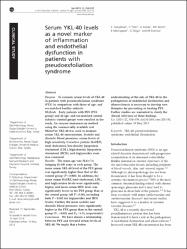| dc.contributor.author | Türkyılmaz, Kemal | |
| dc.contributor.author | Öner, Veysi | |
| dc.contributor.author | Kırbaş, Aynur | |
| dc.contributor.author | Sevim, Mehmet Şahin | |
| dc.contributor.author | Şekeryapan, Berrak | |
| dc.contributor.author | Özgür, Gökhan | |
| dc.contributor.author | Durmus, Mustafa | |
| dc.date.accessioned | 2020-12-19T20:04:22Z | |
| dc.date.available | 2020-12-19T20:04:22Z | |
| dc.date.issued | 2013 | |
| dc.identifier.citation | Turkyılmaz, K., Öner, V., Kırbaş, A., Sevim, M.S., Şekeryapan, B., Özgür, G., Durmuş, M., (2013). Serum YKL-40 levels as a novel marker of inflammation and endothelial dysfunction in patients with pseudoexfoliation syndrome.Eye, 27(7), 854-859.https://doi.org/10.1038/eye.2013.92 | |
| dc.identifier.issn | 0950-222X | |
| dc.identifier.issn | 1476-5454 | |
| dc.identifier.uri | https://doi.org/10.1038/eye.2013.92 | |
| dc.identifier.uri | https://hdl.handle.net/11436/3319 | |
| dc.description | WOS: 000321700800013 | en_US |
| dc.description | PubMed: 23661157 | en_US |
| dc.description.abstract | Purpose To evaluate serum levels of YKL-40 in patients with pseudoexfoliation syndrome (PEX) in comparison with those of age-and sex-matched healthy subjects. Methods Forty patients with PEX (PEX group) and 40 age- and sex-matched control subjects (control group) were enrolled in the study. An enzyme immunoassay method using the commercially available test MicroVue YKL-40 was used to measure serum YKL-40 concentration. Systolic and diastolic blood pressures, serum levels of high sensitivity C-reactive protein (hsCRP), total cholesterol, low-density lipoprotein cholesterol (LDL), high-density lipoprotein cholesterol (HDL), and triglycerides were also examined. Results the mean age was 54.4 +/- 7.6 (ranging 41-65) years in each group. the mean serum YKL-40 level of the PEX group was significantly higher than that of the control group (P<0.001). in addition, the mean serum HsCRP, total cholesterol, LDL, and triglycerides levels were significantly higher, and mean serum HDL level was significantly lower in the PEX group than in the control group (all P<0.001, excluding both P = 0.002 for triglycerides and HDL levels). Further, the mean systolic and diastolic blood pressures were significantly higher in the PEX group than in the control group (P-1 = 0.001 and P-2 = 0.01, respectively). Conclusion We have shown a relationship between PEX and elevated serum levels of YKL-40. We imply that a better understanding of the role of YKL-40 in the pathogenesis of endothelial dysfunction and atherosclerosis is necessary to develop new therapies for preventing or treating PEX. Further studies are warranted to clarify the clinical relevance of these findings. | en_US |
| dc.language.iso | eng | en_US |
| dc.publisher | Nature Publishing Group | en_US |
| dc.rights | info:eu-repo/semantics/openAccess | en_US |
| dc.subject | YKL-40 | en_US |
| dc.subject | Pseudoexfoliation syndrome | en_US |
| dc.subject | Endothelial dysfunction | en_US |
| dc.title | Serum YKL-40 levels as a novel marker of inflammation and endothelial dysfunction in patients with pseudoexfoliation syndrome | en_US |
| dc.type | article | en_US |
| dc.contributor.department | RTEÜ, Tıp Fakültesi, Cerrahi Tıp Bilimleri Bölümü | en_US |
| dc.contributor.institutionauthor | Türkyılmaz, Kemal | |
| dc.contributor.institutionauthor | Öner, Veysi | |
| dc.contributor.institutionauthor | Kırbaş, Aynur | |
| dc.contributor.institutionauthor | Şekeryapan, Berrak | |
| dc.contributor.institutionauthor | Özgür, Gökhan | |
| dc.contributor.institutionauthor | Durmus, Mustafa | |
| dc.identifier.doi | 10.1038/eye.2013.92 | |
| dc.identifier.volume | 27 | en_US |
| dc.identifier.issue | 7 | en_US |
| dc.identifier.startpage | 854 | en_US |
| dc.identifier.endpage | 859 | en_US |
| dc.ri.edit | oa | en_US |
| dc.relation.journal | Eye | en_US |
| dc.relation.publicationcategory | Makale - Uluslararası Hakemli Dergi - Kurum Öğretim Elemanı | en_US |


















